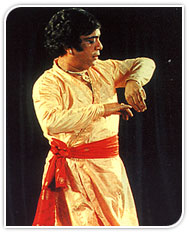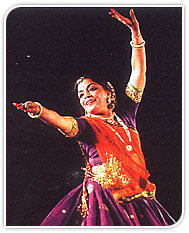Dances of India: Kathak
 Kathaks
were originally storytellers or troubadours who used dance to illustrate
'Kathas' or stories.
Kathaks
were originally storytellers or troubadours who used dance to illustrate
'Kathas' or stories.
They were attached to temples of North India. With
the advent of the Muslim rule, Kathak went from the temple to the courts.
Consequently Kathak flowered as a form in the Hindu courts of
Rajasthan and the Muslim courts of Delhi, Agra and Lucknow.
Court
patronage evolved Kathak into a highly technical and stylised art with
emphasis on the solo performers and their virtuosity.
Gradually,
the two schools became distinctively different - the Jaipur Gharana
focussed on layakari, or rhythmic wizardry, while the Lucknow Gharana
expounded bhava or moods and emotions.
 Nawab
Wajid Alt Shah was instrumental in the, Lucknow Gharana's growth, (see
Satyajit Ray's Shatranj Ke Khilari, deal with the period).
Nawab
Wajid Alt Shah was instrumental in the, Lucknow Gharana's growth, (see
Satyajit Ray's Shatranj Ke Khilari, deal with the period).
However,
both schools have Radha & Krishna as their central theme.
Rhythm,
timing and so footwork are the main planks of Kathak.
The
musical accompaniment to the 200 ghungrus or bells on the dancer's feet,
are the sarangi and the tabla.
Kathak is a true fusion of the
Hindu and Muslim genius in art and it is the only Classical dance of North
India. Kathaks
were originally storytellers or troubadours who used dance to illustrate
'Kathas' or stories.
Kathaks
were originally storytellers or troubadours who used dance to illustrate
'Kathas' or stories. Nawab
Wajid Alt Shah was instrumental in the, Lucknow Gharana's growth, (see
Satyajit Ray's Shatranj Ke Khilari, deal with the period).
Nawab
Wajid Alt Shah was instrumental in the, Lucknow Gharana's growth, (see
Satyajit Ray's Shatranj Ke Khilari, deal with the period).